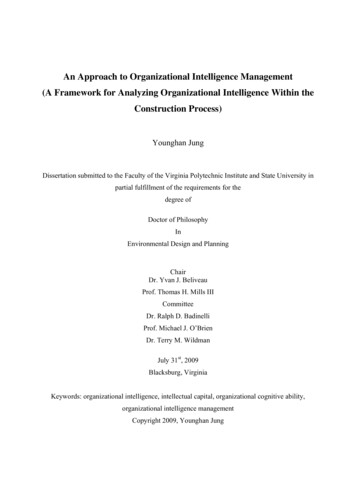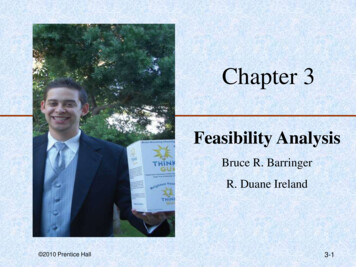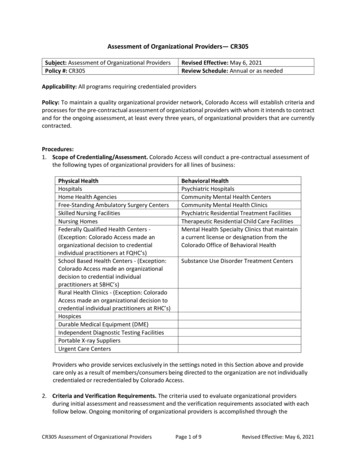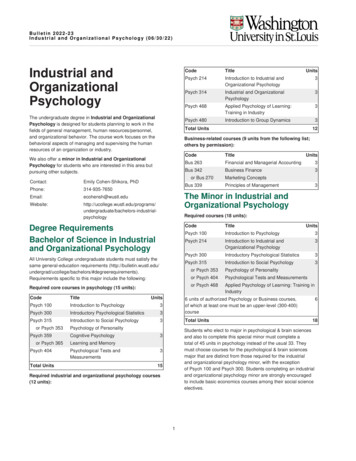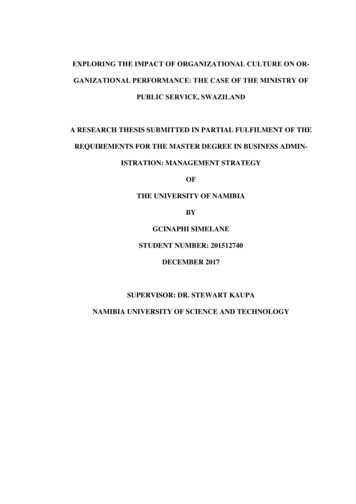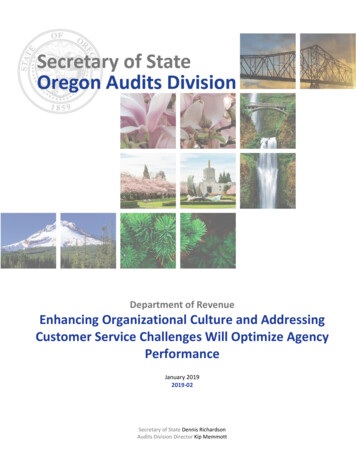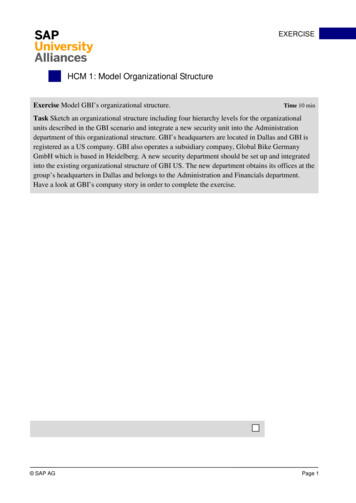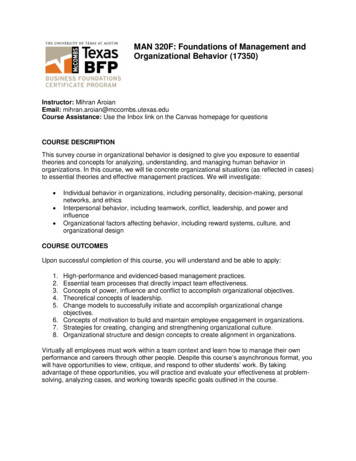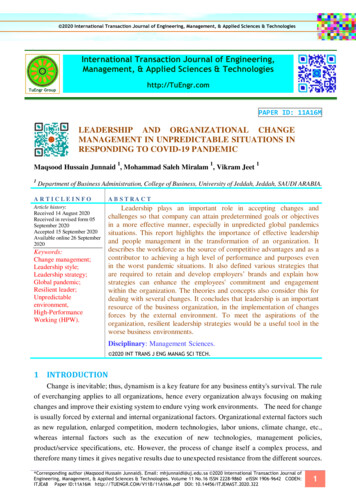
Transcription
Leading Organizational ChangeGina Brimner, MSW, LCSWRobert Dare, Dare Consulting LLCAugust 9, 2022
Disclaimer and Funding StatementThis presentation was prepared for the Mountain Plains Mental Health Technology Transfer Center(Mountain Plains MHTTC) under a cooperative agreement from the Substance Abuse and MentalHealth Services Administration (SAMHSA). All material appearing in this presentation, except that takendirectly from copyrighted sources, is in the public domain and may be reproduced or copied withoutpermission from SAMHSA or the authors. The citation of the source is appreciated. Do not reproduce ordistribute this presentation for a fee without specific, written authorization from the Mountain PlainsMHTTC. For more information on obtaining copies of this presentation please email gberry@wiche.edu.At the time of this presentation, Miriam E. Delphin-Rittmon, Ph.D. served as acting SAMHSA AssistantSecretary. The opinions expressed herein are the views of Gina Brimner and Robert Dare and do notreflect the official position of the Department of Health and Human Services (DHHS), or SAMHSA. Noofficial support or endorsement of DHHS, SAMHSA, for the opinions described in this presentation isintended or should be inferred.The work of the Mountain Plains MHTTC is supported by grant H79SM081792 from the Department ofHealth and Human Services, Substance Abuse and Mental Health Services Administration.
The Mountain Plains Mental Health Technology TransferCenterThe Mountain Plains Mental Health TechnologyTransfer Center (Mountain Plains MHTTC) providestraining and technical assistance to individuals whoserve persons with mental health concerns throughoutRegion 8 (Colorado, Montana, North Dakota, SouthDakota, Utah and Wyoming).We belong to the Technology Transfer Center (TTC)Network, a national network of training and technicalassistance centers serving the needs of mental health,substance use and prevention providers. The work ofthe TTC Network is under a cooperative agreement bythe Substance Abuse and Mental Health ServiceAdministration (SAMHSA).
Mountain Plains MHTTCLeadershipDennis Mohatt,Co-Project DirectorDr. Rachel NavarroCo-Project Director
Land AcknowledgementStatementToday, the University of North Dakota rests on theancestral lands of the Pembina and Red Lake Bands ofOjibwe and the Dakota Oyate - presently existing ascomposite parts of the Red Lake, Turtle Mountain,White Earth Bands, and the Dakota Tribes ofMinnesota and North Dakota. We acknowledge thepeople who resided here for generations andrecognize that the spirit of the Ojibwe and Oyatepeople permeates this land. As a universitycommunity, we will continue to build upon ourrelations with the First Nations of the State of NorthDakota - the Mandan, Hidatsa, and Arikara Nation,Sisseton-Wahpeton Oyate Nation, Spirit Lake Nation,Standing Rock Sioux Tribe, and Turtle Mountain Bandof Chippewa Indians.
Scan this QR code tofollow us onInstagram, LinkedIn,Twitter, andFacebook. You canalso join our e-mailnewsletter!
Leading Organizational ChangeGina Brimner, LSWRobert Dare, Dare Consulting LLCAugust 9, 2022
Leading Organizational ChangeThe leader of the past knew how to tell; the leader ofthe future will know how to ask.– Peter Drucker
Agenda1. Brief introductions2. Attitudes about change3. Key elements to planning and leading change4. Adjourn
Introductions Who are you? What is your position & where?
What kinds of change do youface in the work environment?
Who Moved My Cheese? Do you recognize Sniff, Scurry, Hem andHaw on your team? In yourself?What has helped you/challenged youduring times of change?What are takeaway messages aboutattitudes towards change?This Photo by Unknown Author is licensed under CC BY-NC
ADKAR CheckupAwareness Is your team aware that change is needed?Desire Are staff willing to participate in organizational change?Knowledge Do team members understand how to change and what isnecessary to do so?Ability Do staff have the abilities or skills necessary to enact change?Reinforcement How will you reinforce changes in a way that will sustain theirsuccess?Hiatt, 2006. ADKAR: A Model for Change in Business, Government and Our Community
Individuals Experience Change over TimePerson APerson BPerson CPerson tyKnowledgeReinforcementTime Some learn about changes later than others Some are early adaptors and move quickly through theprocess Some may take longer through phases of changeHiatt & Creasey, 2012. Change Management: The People Side of nforcement
Change Management Model CrosswalkKotterRosenHiatt & CreaseyLarue & SolomonEstablish sense of urgencyVisionAwarenessCreate guiding coalitionTrustDesireWork yourself out of your job – Purpose – strategic directionmake team less dependent on Strategic prioritiesyou over time Outcome-based criteria Performance expectations linked toprioritiesIntegrated solutions requireWhy will change benefitintegrated operations Customers Organization Individuals (what’s in it for me?)Focus on outcomes rather than HOW – crafting the roadmapinputs Ask team to create the roadmap Assess who’s on the bus & who would Irehire tomorrowFrom command and control to Create self-organized teamsstrategic intentWhole systems perspectiveFeedback loop What is working well What’s not working well What should we do differently What do we need from each otherAsk – don’t tellDevelop vision & strategyParticipationKnowledgeCommunicate changevisionEmpower employees forbroad-based e short term winsConsolidate gains andproduce more changeAnchor new approaches arue & SolomonVision SettingCommunicationStaff EngagementSustainingChange
Change Management Getting StaffInputCommunicatingContinuouslyImprovingTools
Integrator Leader Focus on MissionWorkyourselfout of a jobAsk–donnstio dulso ateted tegrarinnsegInt quire ratioeerop’t tell Scan environment to strategicallyleverage efforts Recognize patterns Focus on what, not howFocrat us onher th Outcan ominp esutssemtssy veole pectihW erspFromcommandand controlto strategicintentLarue & Solomon, 2019. Seeing What Isn’t There: A Leader’s Guide to Creating Change in a Complex World. Develop contextual awarenessSee circumstances in context of the whole and inalignment with mission Take time to reflect
Strategic PlanningStrategic DirectionSet By LeadershipStaff Input on How toAchieve ChangesMissionWhat we doGoalsHow we will achieve focus areasVisionWhat we hope to achieveNeeds to Achieve Goals Knowledge/new skills Time ResourcesFocus AreasGeneral areas to be addressed toaccomplish the missionMeasure of SuccessHow we will know we are thereValues/Guiding PrinciplesHow we operate and make decisionsAction Plan to Implement and SustainChangeWho will do what by when
Characteristics of an Effective VisionImaginableDesirableConveys a picture of what the future will look likeAppeals to long-term interests of employees, customers and otherstakeholdersFeasibleComprises realistic, attainable goalsFocusedClear enough to provide guidance in decision-makingFlexibleCommunicableKotter, 2012. Leading Change.General enough to allow individual initiative and alternative responses tochanging conditionsEasy to explain within five minutes
Setting Clear DirectionWHAT is to be accomplished? Strategic priorities Outcome-based success criteria Expectations of performance linked to prioritiesWHY change? How will change benefit customer, organization and individuals? What is risk of not changing?Larue & Solomon, 2019. Seeing What Isn’t There: A Leader’s Guide to Creating Change in a Complex World.
Communicating1. Identify your target audiences and their variedperspectives and interests2. Assess how the message will be heard by receivers3. Share information and power to build trust4. Know your own biases and strive to be inclusive of all5. Maintain a whole systems perspective and encouragecross-team communication6. Convey and model a moral compassCommunicationMethodsFace – to – FaceGroup MeetingsOne – on – oneVirtual MeetingsBehaviorEmailsTrainingsNewslettersOthers?
Creating a Guiding CoalitionPosition PowerExpertiseCredibilityLeadershipKotter, John P., 2012. Leading Change. Are enough key players on board? Does the coalition have enoughvarious points of view? Do coalition members have goodreputations so that they will be takenseriously? Does the group include enoughproven leaders to be effective?
Getting Staff Input on HOW to Change Equip managers to be change leaders Facilitate teams to develop their own solutions Encourage creative and critical thinking Create self-organized team Ask, don’t tell Generate short-term wins Support knowledge and skills development needed to promotechanges
Sustaining ChangeAnchor New Approaches in Culture (Kotter) Culture change follows transformationCulture change depends on resultsCulture change requires a lot of ongoing communicationBuild Community (Rosen) Cultivate maturityInspire pride and performanceCare beyond yourselfChange Reinforcement (Hiatt) Reward successful changeReinforce change competencyManage resistance to changeCreate culture of change as ‘business as usual’
Continue to Learn, Grow, Change What is working well? What’s not working well? What should we do differently?https://deming.org/explore/pdsa/.
Tools to Support Change Management SWOT Analysis Survey Focus group Formal and informal meetings Flow Chart/Process Map Gantt Chart/Action PlanSTRENGTHSWEAKNESSESOPPORTUNITIES THREATS
CHECK OUT
ResourcesHiatt, Jeffrey M. ADKAR: How to Implement Successful Change in Our Personal Lives andProfessional Careers. Prosci Learning Center Publications, 2006.Hiatt, Jeffrey M. and Creasey, Timothy J. Change Management: The People Side of Change.Prosci Learning Center Publications, 2012.Johnson, Spencer. Who Moved My Cheese? An Amazing Way to Deal with Change in YourWork and In Your Life. G.P. Putnam’s Sons, 1998.Kotter, John P. Leading Change. Harvard Business Review Press, 2012.Larue, Bruce and Solomon, Jim. Seeing What Isn’t There: A Leader’s Guide to Creating Changein a Complex World. Deeds Publishing, 2019.Rosen, Robert H. Transforming Business From the Inside Out. Penguin Group, 1996.Sarazin. Action with Traction: A User’s Guide for Getting Results in Your Organization. OlympicPerformance, Inc., 2009.Solomon, Jim and LaRue, Bruce. Thrive Today, Thrive Tomorrow. Chambers Bay 2/01/31/thrive-today-thrive-tomorrow/.
Scan this QR code tofollow us onInstagram, LinkedIn,Twitter, andFacebook. You canalso join our e-mailnewsletter!
Thank you for joining!
Robert Dare, Dare Consulting LLC August 9, 2022 Leading Organizational Change. . Hiatt, 2006. ADKAR: A Model for Change in Business, Government and Our Community. Individuals Experience Change over Time Person A . Focused Clear enough to provide guidance in decision-making Flexible General enough to allow individual initiative and .

